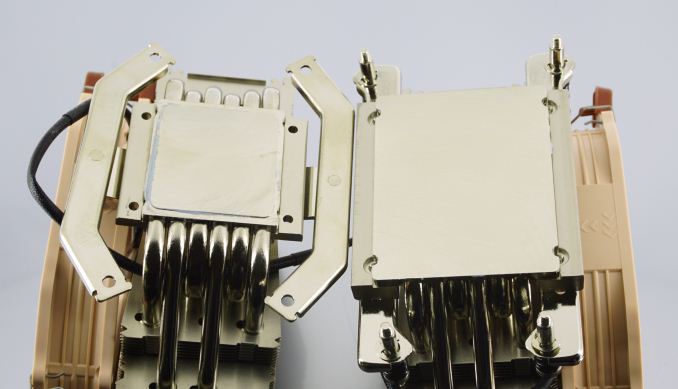Analyzing Threadripper Thermals: Big Base Cooling Wins
by E. Fylladitakis on March 14, 2018 8:30 AM EST- Posted in
- CPUs
- AMD
- Cases/Cooling/PSUs
- Noctua
- ThreadRipper
- 1950X
- CPU cooler

Ever since their launch last year, AMD’s Threadripper CPUs have been the center of many discussions and debates. Due to their unique design – both physically and architecturally – cooling requirements and efficiency are some of the major discussion topics. All of the Threadripper models have significant power and cooling requirements, with AMD recommending liquid cooling right off the bat. However, the actual thermal design power (TDP) specifications are not that high, suggesting that a good air-based cooler could easily cope with the thermal load. And here is where things are getting complicated.
Threadripper processors step quite far outside typical CPU designs in several ways, one of which is their relatively massive physical size. The CPU’s surface area is much greater than that of all consumer CPUs before them, including Intel's LGA 20xx sockets. This sizable design choice is not because AMD couldn't squeeze the CPU dies physically closer, but because Threadripper's size is the minimum size that their engineers calculated to be effective for both the mechanical strength of the package and for sufficient heat dissipation. When Threadripper was announced, nearly all cooler manufacturers rushed to provide adapters for their products to be mounted on Threadripper processors. AMD themselves include an adapter for Asetek-based liquid coolers inside the package of the Threadripper processors. User experiences with such adapters, including our own, were less that ideal. So today we're going to take a look at why AMD's thermal requirements are so exaggerated and showcase why adapters are not effective.
AMD Threadripper Coolers: Almost the Same, But Not Quite
Most available coolers were designed with the previous generation processors in mind, and their contact surface is significantly smaller than the CPU’s surface area. Many manufacturers rushed to offer adapters for their products to be mounted on Threadripper (socket TR4) processors and several posted/presented simple mods that convert AM4-compatible coolers to fit as well. Using socket adapters and mounting typical coolers on Threadripper processor does work, but they are only partially covering the CPU’s surface area.

Left - Noctua NH-U14S with AM4-UxS mounting braces, Right - Noctua NH-U14S TR4-SP3
There have been many debates whether the same exact cooler but with a proper contact surface would have better thermal conductance. According to basic thermal engineering theory, the cooler whose base covers more of a processor's lid should perform better. In the following pages we examine the theoretical aspect of this supposition and follow up with an experimental case study.










43 Comments
View All Comments
Ryan Smith - Wednesday, March 14, 2018 - link
To clarify, the title of page 2 is a bit of humor. E. isn't a doctor (though Ian is).LordanSS - Wednesday, March 14, 2018 - link
Thank you for the article. It was a good read with the thermodynamics explanation as well.fackamato - Wednesday, March 14, 2018 - link
What are the decibels during load for each cooler/rpm?Valantar - Wednesday, March 14, 2018 - link
A fascinating read. Now for the follow-up: an article where you test sticking two 212 Evos side by side on a Threadripper. That should cover most of the IHS, no?LanceLLandon - Wednesday, March 14, 2018 - link
My preference is Peltier air cooling. By cooling a processor slightly frozen less thermal noise is generated and less miscalculations are performed. Perhaps this is more important for studio Sound Recording and Mixing/Editing or Movie Video Editing or for Work Station performance. If I am going to all the trouble to build a multi core computer I will also so go to the trouble of cooling it far more effectively.MrSpadge - Wednesday, March 14, 2018 - link
A Peltier cooler will help you with extreme OC, if sized properly, but apart from that will only increase your energy consumption significantly. If you want lower temperatures go for chilled water, that's far more efficient. But you absolutely don't need that. Otherwise all the servers in data centers, DELL shops etc. would have to be constructed differently. And if you really want to reduce the chance of calculation errors beyond the manufacturer specification, simply drop the CPU clock by 100 MHz.BTW: are you using ECC RAM? Not that I'm recommending it for home computers, but if not you're definitely overshooting with that Peltier and should care for more probable points of failure first.
Crazyeyeskillah - Wednesday, March 14, 2018 - link
Water or GTFO.master381 - Wednesday, March 14, 2018 - link
Nice article!A question - on Page 3, is this supposed to read " absolute thermal resistance of the cooler itself needs to be very *low,*" instead of high?
Excerpt:
"The high thermal resistance caused by an undersized contact plate cannot be easily countered, which is why the absolute thermal resistance of the cooler itself needs to be very high, i.e. why AMD’s cooler recommendations are so over the top."
Ryan Smith - Thursday, March 15, 2018 - link
That was meant to read "thermal conductance". Thanks!zodiacfml - Wednesday, March 14, 2018 - link
The conclusion I can get from here is that desktop CPU with around 90W TDP can also benefit from the larger surface area, considering the differences in temps at idle of the TR chip.